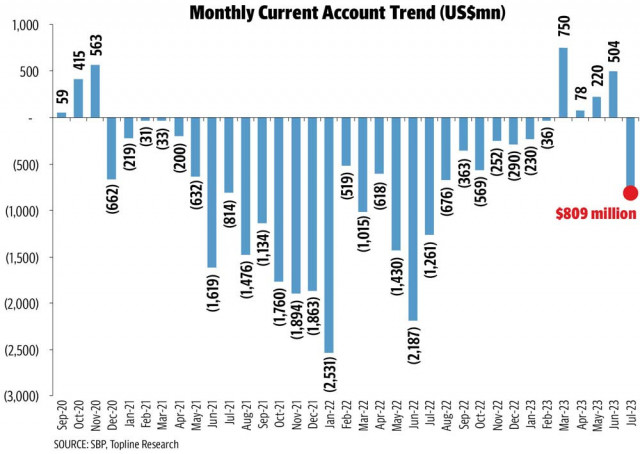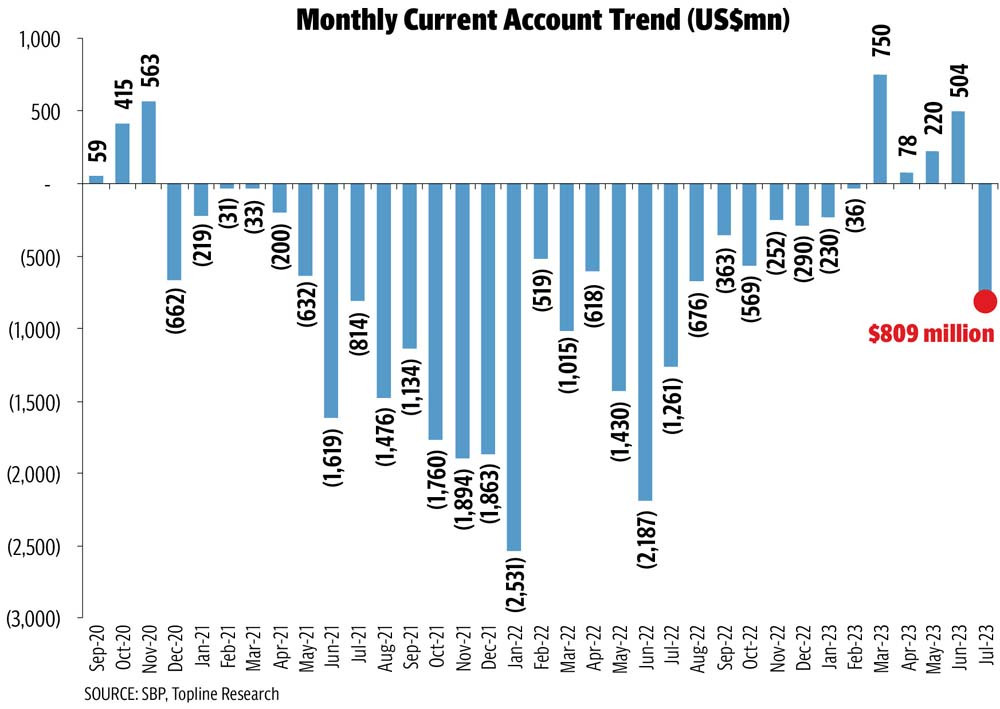Current account in deficit again
Deficit stands at $809m for July compared to surplus in past four months

Pakistan’s current account balance again landed in negative zone, registering a deficit of $809 million in July, in the wake of a jump in import payments and slump in worker remittances, ending the streak of surpluses achieved over the past four months.
The deficit was slightly higher than market expectations of around half a billion dollars as traders made pending import payments after the government lifted restrictions on the purchase of all kinds of raw materials and finished goods from overseas markets.
The curbs were removed on the International Monetary Fund (IMF)’s recommendation under a new, nine-month $3 billion loan programme awarded late in June 2023.
Talking to The Express Tribune, Arif Habib Limited economist Sana Tawfik said “the uplift in imports and the drop in worker remittances remained the two major contributors to the widening current account deficit in July on a month-on-month basis.”
Another analyst, who spoke on condition of anonymity, said a major growth in import payments was observed in the category of other goods, which remained unclear so far. “One has to check what these imports are.”
The State Bank of Pakistan (SBP)’s data showed that payments for import of goods increased 33% to $4.22 billion in July compared to $3.18 billion in the prior month.
The government had kept imports below $4 billion a month in the past few months to cope with its critically low foreign exchange reserves and as a result it was able to mitigate the risk of debt default.
On the other hand, the inflow of remittances sent home by overseas Pakistanis slowed down 7% to $2.03 billion in July compared to $2.19 billion in June.
It came after some expatriate Pakistanis apparently shifted to unofficial channels for sending money to their relatives in the country owing to better prices for foreign currencies in the illicit market.
An analyst said “the previous PDM (Pakistan Democratic Movement) government artificially stabilised the rupee-dollar exchange rate in the inter-bank market over the past couple of months, but it kept depreciating in the illegal Hawala-Hundi network.”
In July, export earnings remained stable at $2.11 billion compared to the previous month. Exports will, however, remain under pressure in the coming months due to a global economic slowdown and high inflation in different parts of the world.
On a year-on-year basis, the current account deficit shrank almost 36% to $809 million in July compared to $1.26 billion in the same month of last year.

design: mohsin alam
In the prior four months (March-June), Pakistan recorded a cumulative current account surplus of $1.50 billion through controlling imports and compromising economic activities. This resulted in closure of factories completely or partially and rendered millions of people jobless.
For the full previous fiscal year, the current account deficit narrowed a staggering 86% to $2.38 billion (less than 1% of GDP) compared to $17.48 billion in FY22.
Tawfik said the current account deficit would slightly increase in the current fiscal year because the government had reopened all kinds of imports with the prime objective of boosting economic growth to the targeted level of 3.5% compared to 0.3% in FY23.
The SBP has projected current account deficit in the range of 0.5% to 1.5% of gross domestic product ($3.5 billion to $5 billion) for FY24 with economic growth of 2-3%.
Experts said though the government had removed all restrictions, import volumes would remain low in FY24 due to stagnation in the inflow of US dollars into the national economy.
Imports will be equal to the sum of export earnings and worker remittances and not more than that. Inflows from the IMF and fresh deposits from friendly countries will help improve Pakistan’s foreign exchange reserves and repay the maturing foreign debt.
“Pakistan is projected to arrange $15-16 billion in FY24 to repay the maturing foreign debt, make interest payments on debt and finance the current account deficit,” Tawfik said.
In total, Pakistan is to repay slightly less than $24.5 billion in foreign debt and interest cost in the year. However, the government is expected to get some of the debt rolled over and refinance around $11 billion.
Published in The Express Tribune, August 19th, 2023.
Like Business on Facebook, follow @TribuneBiz on Twitter to stay informed and join in the conversation.



















COMMENTS
Comments are moderated and generally will be posted if they are on-topic and not abusive.
For more information, please see our Comments FAQ